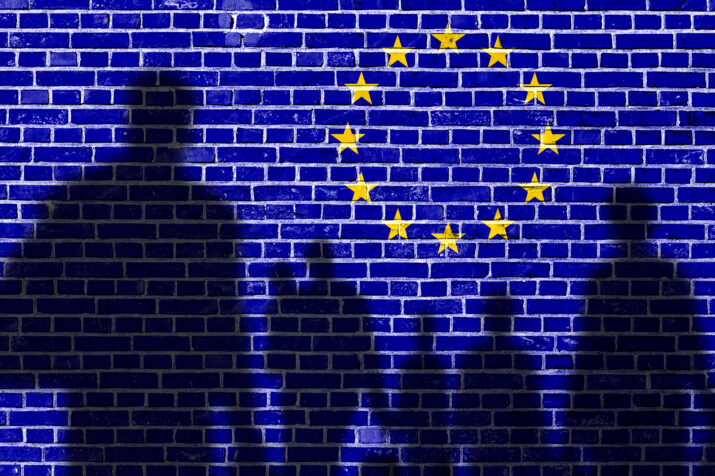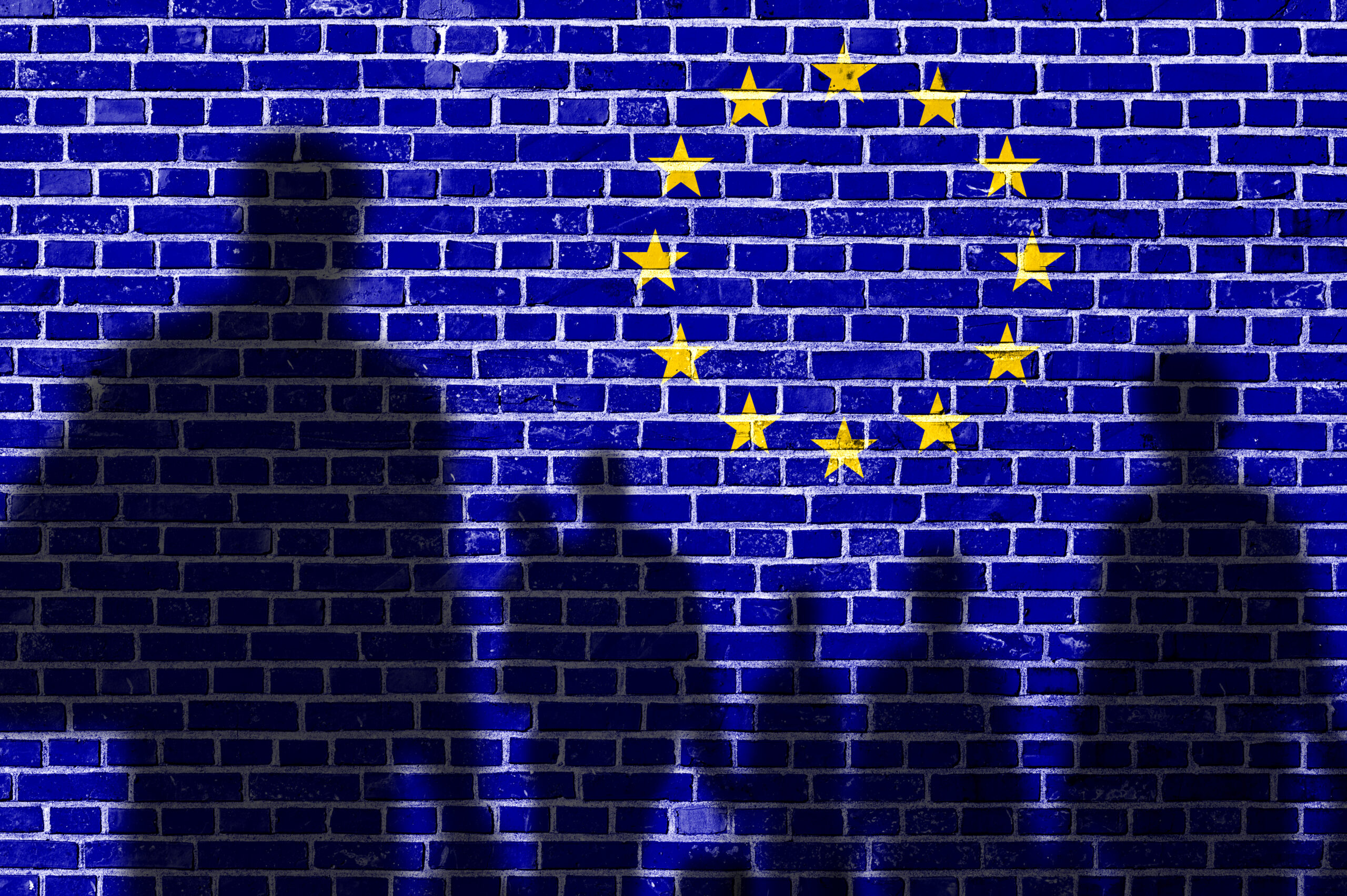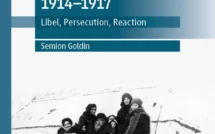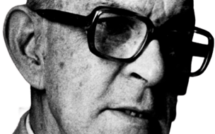

This is part of our special feature, The Politics of Postmigration.
On 5 September 2015, the German government temporarily relaxed its restrictive border policies toward people fleeing their countries. At the same time, the word “Flüchtlingskrise” (“refugee crisis”) started appearing in the media. Gradually, political commentaries portraying refugees as a threat to the European population began to dominate. However, as the controversy surrounding the “refugee crisis” concentrated particularly on topics such as border controls and security checks (Scherr 2017, 91), the viewpoints of the refugees themselves were largely disregarded. This article explains how artistic interventions can represent experiences of migration and marginalized forms of knowledge. It identifies the opportunities postmigration artistic practices provide to reach out to host societies. In this context, “postmigration” refers to the phase or state people are in after migration, which entails the permanent coming, going, and staying of people as an essential part of social coexistence. Postmigration refers to a cosmopolitan process that involves looking for blind spots and keeping an eye on which kind of migration stories are anchored in social consciousness and which are not. Furthermore, the postmigrant perspective focuses on the present and asks which social and societal conflicts related to migration are currently developing and will be highly relevant for future generations. Ultimately, the prefix “post” in the social sense marks neither a temporal conclusion nor the end of migration. A postmigrant perspective is an expression of a reflexive view of the society being shaped by migration. This view allows for coming to terms with migration histories that may have penetrated the social consciousness or, on the contrary, have been suppressed and ignored. It is crucial to show that migration is part of social normality and that it moves and develops society. Considering migration, marginalized memories, and experiences of flight and migration makes it clear that these experiences represent important social resources.
The objective of this research is to relate the hegemonic discourse on forced migration to refugees’ own stances and experiences and to include in that discourse the matters that concern refugees, paying particular attention to their perspectives, which have been excluded. The first step entails questioning how refugees have been marginalized in the European discourse on forced migration and how they have been selectively portrayed as lacking agency. To counter this portrayal, postmigrant perspectives are highlighted and discussed based on a critical appraisal of vulnerability that focuses on a public discussion that took place at the 2018 Wiesbaden Biennale on the topic of “Saving Europe? Or letting it be?” [1] The intervention of the artistic group “migrantenstadl” explicitly brought different forms of agency and vulnerability to the public’s attention. Artistic interventions have the potential to bring together a wide variety of people in one place, making it possible for postmigrant solidary alliances to be forged between people whose lifeworlds may differ significantly. Moreover, such solidarity arises out of matters that are important to society as a whole.
The postmigrant perspective
In his book “Nach der Flucht” (“After Fleeing”, 2017), psychologist Mark Terkessidis takes a postmigrant perspective, calling for a plural society based on multiplicity. Rather than asking how individuals can be integrated in a given society, he proposes a plan to examine how everyone in and outside Europe can shape the future of Europe together. In his opinion, the idea that migration is a fundamental element of our coexistence is indisputable, as is demographic change:
Ever since some 900,000 people fled to Germany in 2015, debates on the topic of migration have become increasingly heated. This event has actually driven it home to everyone that immigration is no longer just a marginal issue (Terkessidis 2017, 8; translation by the author).
Terkessidis (2017) primarily interprets the pessimistic discussions that have taken place about refugee migration and the opening of routes into Europe as reflecting a lack of genuine societal reform. Rather than starting with migration to re-imagine how people can live together in society, the public discourse on refugee migration has focused on policies of division, as have political actions on the topic. Moreover, the realities of refugees’ lives, their experiences, and their modes of agency have rarely shaped the public discourse. When addressing the way in which the phenomenon of forced migration has been tackled, sociologist Erol Yildiz considers especially problematic that refugees have been stigmatized as victims; indeed, their strength, abilities, and everyday needs have been largely ignored in the public discourse on refugee migration. However, he believes that refugees must be viewed in a different light; thus, he radically shifts the focus to the ways in which refugees have agency (Yildiz 2017). In relation to implementing a plan for a plural society characterized by multiplicity, Yildiz sees most potential in the instilling of a cosmopolitan mindset within the structure of the educational landscape. With historian Wolfgang Meixner, he states,
Educational institutions in particular should develop a cosmopolitan mindset and recognize that this mindset involves certain resources that have multiple geographical, biographical, cultural, and social roots. In brief, these institutions should promote a sensitivity to multiplicity (Yildiz and Meixner 2021, 74; translation by the author).
Current works in critical migration research primarily indicate the need to view the wider discourse on refugee migration from an alternative angle; they call for an examination of the situation that “consistently takes into account the narratives and stories recounted by the people who have actually fled their homes” (Schacht 2019, 126). Frauke Schacht, a migration researcher in charge of the Innsbruck refugee counseling center “FLUCHTpunkt,” goes on to highlight that we need to create “spaces that enable refugees’ many voices to be heard” (Schacht 2019, 126; translation by the author).
The main objective of researching refugees’ resilience and subjectivity is to shed light on prevailing power differentials. This type of research also gives a voice to those whose knowledge has been ignored, excluded, or obscured by hegemonic discourses in a way that has favored the emergence of marginalized forms of knowledge. Through cultural studies and in line with Rainer Winter’s analysis of the “enigma of agency,” it can be argued that conducting critical migration research that privileges marginalized migration experiences can impact hegemonic discourses; therefore, this type of research can be interpreted as political practice (Winter 2018, 174). Understanding migration research as social research that takes the experience of migration and social inequalities in the age of globalization as its starting point indicates that, in the words of social pedagogue Albert Scherr (2021), it is time to realize that we truly all live together on one planet.
Art practice meets border politics
[Migrant Barn] migrantenstadl is a blog produced by and for border crossers, dadaists, and keyboard terrorists; it includes provocative, subjective, and political opinions and stories from the migrant milieu and beyond, in Munich, and elsewhere. Migrantenstadl is the voice from the heart of the margins! (2023; translation by author).[2]
In its contribution to the exhibition at the Wiesbaden Biennale in 2018, a group collectively named “migrantenstadl” asked how to rid “Fortress Europe” of its restrictive refugee migration policy. Migrantenstadl’s interventions have been used by scholars in critical migration research as postmigrant art practices; these specialists have, for example, interpreted these interventions based on the postmigration solidarity it proposes (Hill 2019a; Maeding 2016; Rotter et al. 2021). Tunay Önder and Imad Mustafa, who created migrantenstadl, have themselves directly participated in the academic debate. They have also given interviews, published articles on their online blog,[3] and curated books about art (Hill 2019b; Mustafa and Önder 2016; Önder 2013).
Migrantenstadl’s agenda at the Wiesbaden Biennale listed a performance entitled “Europa retten? Oder soll man es lassen?” (“Saving Europe? Or letting it be?”). The event consisted of a panel discussion that featured a conversation between a DJ, an ocean lifeguard, individuals from academia and the art world, a wordsmith, and guests from the audience. Since the name “migrantenstadl” is a play on the name “Musikantenstadl”—a folksy Bavarian TV show set in a Stadl or barn—the event took place in a large, dimly lit theater in the middle of Wiesbaden that was set up to look like a Mediterranean, Hessian, or Turkish “migrant barn” through the use of props such as brimming Turkish teacups and pumpkin seeds on which to snack. A microphone hung from a 15- to 20-meter-high ceiling in front of the audience and was open for use at any time. A bright spotlight was directed to the area as if it were a stage. The panelists sat in the middle of the room, around a large, brightly lit round table positioned at the same level as the audience’s sitting area. Thus, the audience, which sat at small garden tables, on scattered sofas, or on an Oriental-looking rug, was placed on an equal footing with the panelists.
The discussion began with a re-/de-construction of images of refugees as victims, perpetrators, and rescuers, which was accompanied by calls for a humanitarian Europe. The political construction of refugees as victims in Europe has often been supported by the idea that Europe considers itself a safe place for human rights. As perpetrators, refugees are imagined as people who were not forced to flee from their countries of origin but only sought to improve their economic situation. In many ways, refugees appear in the hegemonic discourse as people seeking to exploit the European social and economic system. Images of refugees as victims have come with images of Europeans rescuing them and giving them protection (Niedrig and Seukwa 2010).
During the performance, a woman suddenly stood up. She seemed slightly agitated or annoyed and did not want to use the open microphone; therefore, she was handed another microphone. She started by introducing herself to the audience as coming from Canada and having a PhD in mechanical engineering; she then described her everyday life and reported on the difficulties of her situation as a person of color in Germany. She explained that due to her precarious social status, she had not been able to work or live independently, whether in Germany or in any African country. She also reported that her daughter had married a European, hence had permanent resident status. She also stressed that it was Europe that benefited most from development programs in African countries. For example, she mentioned the transfer of technology from Europe to Africa and the creation of new jobs for Europeans in Africa. The audience was impressed with her contribution based on the fact that she was an expert in her own lifeworld; as a specialist in international mechanical engineering and, above all, as a human being, she disrupted the discourse on refugee migration that had been built around the idea of perpetrator, victim, or savior.
In the course of an informal conversation after the event, she explained that she had deliberately first positioned herself as a Canadian academic so that the audience would acknowledge and listen to her. The woman’s comments not only deconstructed the usual perspective of Europe as savior; they turned that perspective on its head. In fact, her comments initially left the audience and panelists at a loss for words. After a few brief expressions of empathy, her knowledge was generally simply ignored by many of those involved in the discussion; someone remarked that subjective descriptions of individual cases should not be allowed to distract from the general landscape of European security policy. After the discussion, the organizers of migrantenstadl discussed how they should address vulnerabilities expressed by participants in light of potential belittling reactions. Through their cultural analysis and artistic activities, the artists who are part of migrantenstadl themselves had become part of the political discourse and thus also experienced the daily reality of socially marginalized people. Neither the participant in question nor those involved in migrantenstadl were prepared to accept and internalize the established mechanisms used to portray certain people as inferior.
The unforeseeable situation and the eventfulness of the woman’s speech also translated the vulnerabilities inherent in resistance. However, in contrast to the study by Elias and Scotson (2016), the “outsiders” in this discussion did not appear as victims incapable of defending themselves. In the case of the migrantenstadl panel discussion, a woman spoke out despite being in a largely powerless position. She explained her precarious situation in life and drew attention to social and societal inequalities. It was nonetheless clear that whatever turn the argument took that evening, it would not change her personal situation in the short term. The woman even seemed unaware of her own vulnerability but also of the fact that she was defenseless against the prevailing circumstances and in many ways that she was at the mercy of structural disadvantages and discriminatory practices. However, her comments revealed subject-centered strategies of self-empowerment. The fact that she spoke up and adopted a stance on what was being said in the panel discussion can be interpreted as a strategy of resistance. Experiences of flight and migration are rarely perceived in differentiated ways in social discourse, and people tend to talk about refugees rather than with them; therefore, it is all the more important that people can find places in which to belong. Where people find no one to advocate for them, it is important to foster places where they can express themselves. Public exchanges and expressions of solidarity are critical to strengthen the agency of vulnerable people to act.
Resistance as a practice of knowledge production
The migrantenstadl event was held at the Wiesbaden Biennale as part of the topic “Saving Europe? Or letting it be?” The event can be interpreted as a solidary practice carried out as an art activity that included refugees. This type of events, usually held in urban areas in Germany, clearly show that knowing about extremely diverse contexts matters in articulating and bringing to the fore controversial discourses on refugee migration. Indeed, these contexts allow for new outlooks on cities and migration to develop and for postmigration alliances and reflective forms of solidarity to be created. The artistic event in Wiesbaden demonstrates that the discursively produced differences between non-refugees and refugees are reproduced again and again in public discussions but also that these differences can be counteracted by means of postmigrant interventions. The live migrantenstadl interventions also demonstrate the discomforting effect that hegemonic interpretive schemes can have in a public setting and how marginalized forms of knowledge are injected into the discourse. This articulated resilience constitutes a political act based on the recognition that migration is a fundamental element of superdiverse urban environments. This act makes clear that treating refugee migration, migration in general, and migration within Europe in a restrictive manner affects society as a whole because of certain cosmopolitan practices and policies currently being implemented and increasingly envisaged there—for example by civil society authorities and associations and social work institutions. In the urban context, the United Nations’ Department of Economic and Social Affairs and organizations such as EUROCITIES have sought to enhance the sustainability of communal life by developing solidary cities and community safety and by encouraging civil society to commit to combat racism. Ultimately, the goal is to construct inclusive systems of belonging, for example by issuing municipal identification cards for undocumented individuals, delivering visas, and making locations attractive through the development of a high quality of life and welcoming environments for migrants (Hillmann 2022). Integrating the lifeworld experiences of people who have gone through refugee migration is an essential aspect of developing postmigrant perspectives on agency. Moreover, it is the only way to paint an unvarnished picture of the legal obstacles to be overcome or the lack of opportunities social services face when trying to make a difference (Seukwa 2005, 217). Such approach is relevant to society as a whole and draws attention to people’s agency. People are thus able to imagine the future, picture their experiences, and cope with contradictions. Moreover, in the context of a global solidary society, the act of viewing refugees as independent actors who have their own position in the discourse on refugeeism constitutes a practical model based on human rights and agency (Hill and Schmitt 2021).
However, it is crucial to think in multi-contextual, relational, counterbalancing terms when analyzing the range of actions available to institutions, which are subject to restrictive asylum policy, while also recognizing the forms of agency and resilience refugees possess as subjects. People who have fled their homes are particularly defenseless and vulnerable in many respects, as demonstrated by the woman speaking out during the panel discussion. Hence, social pedagogue Caroline Schmitt acknowledges that a combination of relational understandings of agency and vulnerability is particularly important in social work (Schmitt 2019, 287). Seen through the lens of postmigration, the artistic intervention at the Wiesbaden Biennale makes the point that people and borders should not be weighed against one another: issues affecting society and people should be considered in conjunction. An optimistic approach should thus be developed to cope with complexity—an approach that is open-minded but does not filter issues through rose-tinted glasses. Critical—yet optimistic—thinking highlights that the live art event in Wiesbaden allowed for refugees’ agency to lessen structural barriers and forms of vulnerability. This agency combined with solidary alliances uniting special interest groups, art interventions, and civil society.
Marc Hill is Professor of Education with a focus on postmigration studies at the University of Innsbruck. His research interests include urban education and working on academic formats involving artistic, creative, and journalistic performances and expressions.
References
Elias, Norbert, and John L. Scotson. 2016. Etablierte und Außenseiter. Berlin: Suhrkamp.
Hill, Marc. 2019a. Integration postmigrantisch gelesen. In Migration bewegt und bildet. Kontrapunktische Betrachtungen, edited by Alexander Böttcher, Marc Hill, Anita Rotter, Frauke Schacht, Maria A. Wolf, and Erol Yildiz. Innsbruck: Innsbruck University Press, 29-42.
Hill, Marc. 2019b. “Aynwanderunk – Nix Sürük!” Ein Interview mit Tunay Önder (migrantenstadl). In Migration bewegt und bildet. Kontrapunktische Betrachtungen, edited by Alexander Böttcher, Marc Hill, Anita Rotter, Frauke Schacht, Maria A. Wolf, and Erol Yildiz. Innsbruck: Innsbruck University Press, 55-67.
Hill, Marc, and Caroline Schmitt. 2021. Solidarity Cities: Auf dem Weg zu einer neuen “Weltsolidargesellschaft”?. Sozialmagazin, no. 7–8: 33–41.
Hillmann, Felicitas. 2022. “Weg vom Katzentisch. Neues zum komplexen Verhältnis von Stadt und Migration. Die Architekt, “Projekt Erde Vom Wissen zur Alltagspraxis,” 4/22: 31–35.
Maeding, Linda. 2016. The Digital Archive of Diaspora: Blogging (Post)Migration. TRANSIT vol. 13, no. 2: 83–97.
Mustafa, Imad, and Tunay Önder. 2016. migrantenstadl. Münster: Unrast.
Niedrig, Heike, and Louis Henri Seukwa. 2010. Die Ordnung des Diskurses in der
Flüchtlingskonstruktion: Eine postkoloniale Re-Lektüre. Diskurs Kindheits- und Jugendforschung, no 2-2010: 181-193.
Rotter, Anita, Florain Ohnmacht, and Erol Yildiz. 2021. Solidarität postmigrantisch gelesen. Sozialmagazin, no. 7–8: 42–49.
Schacht, Frauke. 2019. “So, we’re civilized” – eine kontrapunktische Perspektive auf die Flüchtlingskategorie. In Migration bewegt und bildet. Kontrapunktische Betrachtungen, edited by Alexander Böttcher, Marc Hill, Anita Rotter, Frauke Schacht, Maria A. Wolf, and Erol Yildiz. Innsbruck: Innsbruck University Press.
Scherr, Albert. 2021. “Das Bewusstsein dafür stärken, dass wir tatsächlich alle auf einem Planeten leben.” Ein Interview zu Solidarität, Antirassismus und der Kraft von Utopien. In Solidarität in Bewegung. Neue Felder für die Soziale Arbeit, edited by Marc Hill, and Caroline Schmitt, Baltmannsweiler: Schneider Verlag Hohengehren, 35-47.
Scherr, Albert. 2017. Die Abschwächung moralischer Empörung. Eine Analyse politischer Reaktionen auf zivilgesellschaftliche Proteste gegen Gesetzesverschärfungen und Abschiebungen. Z’Flucht. Zeitschrift für Flüchtlingsforschung, 1/2017: 88–105.
Schmitt, Caroline. 2019. Agency und Vulnerabilität. Ein relationaler Zugang zu Lebenswelten geflüchteter Menschen. Soziale Arbeit, 58/8: pp. 282–288.
Seukwa, Louis Henri. 2005. Der Habitus der Überlebenskunst. Zum Verhältnis von Kompetenz und Migration im Spiegel von Flüchtlingsbiographien. Münster, New York, Munich, Berlin: Waxmann.
Önder, Tunay. 2013. Was sind Migrant/-innen anderes als babylonische Botschafter des Paradieses? Migrantenstadl 2.0. In Migration und künstlerische Produktionen. Aktuelle Perspektiven, edited by Burcu Dogramaci, Bielefeld: Transcript.
Terkessidis, Mark. 2017. Nach der Flucht. Neue Ideen für die Einwanderungsgesellschaft. Ditzingen: Philipp Reclam jun.
Winter, Rainer. 2018. Praktiken des Eigensinns und die Emergenz des Politischen. In Enigma Agency. Macht, Widerstand, Reflexivität, edited by Hans-Herbert Kögler, Alice Pechriggl, and Rainer Winter, Bielefeld: Transcript.
Yildiz, Erol. 2017. Nach der Flucht: Vom Opferdiskurs zur (Über)Lebenskompetenz. In https://www.imblog.at/nach-der-flucht-vom-opferdiskurs-zur-ueberlebenskompetenz/
(accessed 17 December 2022).
Yildiz, Erol, and Wolfgang Meixner. 2021. Nach der Heimat. Neue Ideen für eine mehrheimische Gesellschaft, Ditzingen: Philipp Reclam jun.
[1] This article is a partially shortened and revised English translation of Hill, Marc. 2019. “Europa retten? Agency in der Migrationsgesellschaft. (Saving Europe? Agency in a society shaped by migration)” Soziale Arbeit 58:8, pp. 302–308. The present article centers on the postmigrant art practiced by “migrantenstadl” at the Wiesbaden Biennale in 2018.
[2] For more information, please visit http://dasmigrantenstadl.blogspot.com/
[3] https://dasmigrantenstadl.blogspot.com/ (accessed 9 February 2023)
Published on May 1, 2023.




